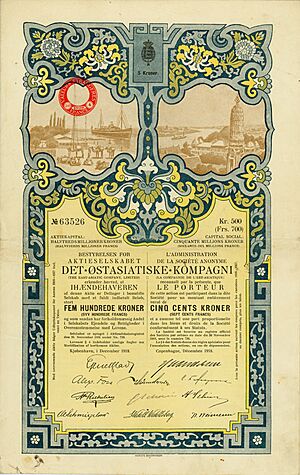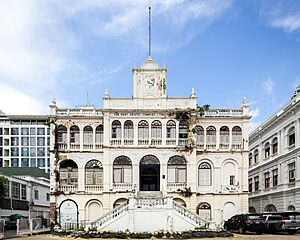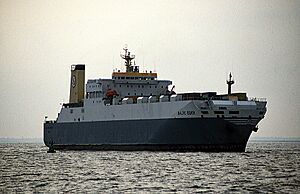EAC Invest A/S facts for kids

|
|
|
Formerly
|
East Asiatic Company Santa Fe Group |
|---|---|
| Aktieselskab | |
| Industry | Investment |
| Founded | 1897 in Copenhagen, Denmark |
| Founder | Hans Niels Andersen |
| Headquarters | , |
| Subsidiaries | Russian East Asiatic Siam Steam Navigation Est Asiatique Francais Swedish East Asiatic D/S A/S Orient |
The EAC Invest A/S is a company based in Copenhagen, Denmark. It used to be known as the Santa Fe Group and the East Asiatic Company. This company is a "holding and investment company." This means it owns parts of other companies and invests money in them.
It was started by Hans Niels Andersen in 1887. Over time, it grew to own several smaller companies around the world. These included companies in Saint Petersburg, Bangkok, Paris, Gothenburg, and Copenhagen.
A Look Back: The East Asiatic Company
How It Started
The East Asiatic Company, or ØK in Danish, was officially founded on March 20, 1897. It was started by Hans Niels Andersen in Copenhagen. He built it from his earlier business, Andersen & Co.
Andersen & Co began in 1884 with Andreas du Plessis de Richelieu. They owned the Oriental Hotel in Bangkok. This was the first foreign hotel in Thailand. Their company also supplied the Siamese Marine Forces.
The Oriental Hotel was bought by Hans Andersen and Captain Peter Andersen in 1884. They borrowed money to fix it up. Since it was one of the few hotels in Bangkok, it was popular with sailors and officers.
Growing Globally
Hans Andersen got money from Isak Glueckstadt to help the company grow. Isak was a key person at Landmandsbanken, a large bank. The company grew by buying land in Siam (now Thailand) to harvest teak trees.
They started shipping goods and people directly from Bangkok to Europe. Soon, they added routes to the Baltic Sea and Black Sea. In 1899, they formed a new company called Russian American Line in St. Petersburg.
The company kept expanding its reach. In 1902, they started Est Asiatique Francais in Paris. Then came the Danish West Indian Company in 1905. The Siam Steam Navigation Company followed in 1908. The Thai government took over this company in 1941. It was then renamed Thai Navigation Co.
For trade in Southern Africa, the Swedish East India Company began regular trips. The Russian American Line started sailing to North America in 1916. Another company, the Baltic American Line, continued this service from 1921 to 1930. The East Asiatic Company also shipped goods for others. This started in 1915 with D/S A/S Orient of Copenhagen.
In 1905, the company bought Water Island in the Caribbean. They sold it to the United States in 1944. This happened during the time Germany occupied Denmark.
The company was a leader in building large ships that ran on diesel engines. Hans Andersen ordered two such ships, the MS Selandia and MS Fionia. They were built by Burmeister & Wain.
The Selandia started sailing in 1912. The Danish crown prince and princess were on its first trip. It then visited London, where it caused a lot of excitement. Important people like Winston Churchill came to see it. A third ship, MS Jutlandia, was built in Scotland. It was the second large diesel ship used by any company. By 1935, the company had 27 diesel ships.
Business grew a lot during these years. In 1919, they partnered with Andrew Weir & Co. to form the United Baltic Corporation. In the early 1920s, their services reached South Africa, Cuba, Australia, Mexico, and North Pacific ports. By 1940, their ships also stopped in New York, Philadelphia, Baltimore, and Norfolk. In 1949, they bought Johnson Walton Steamships Ltd. This helped them connect Vancouver with the Far East.
After the Wars
During the Second World War, several of the company's ships were sunk. Most were hit by German U-boats in the Atlantic Ocean.
After the war, air travel became very popular. Because of this, the company sold many of its ships in the 1950s and 1960s. They stopped all passenger ship operations in 1969. Their last passenger ship, Fionia, was sold to buyers in Switzerland.
In April 2015, the company changed its name to the Santa Fe Group. Its stock market listing also changed. From 2016 to 2019, the company's value dropped a lot. Its income also decreased.
In September 2019, the Santa Fe Group was sold for 1 million euros. It was bought by Proventus Capital Partners. The company had struggled to improve its financial health. In November 2019, the Santa Fe Group became EAC Invest, its current name.






